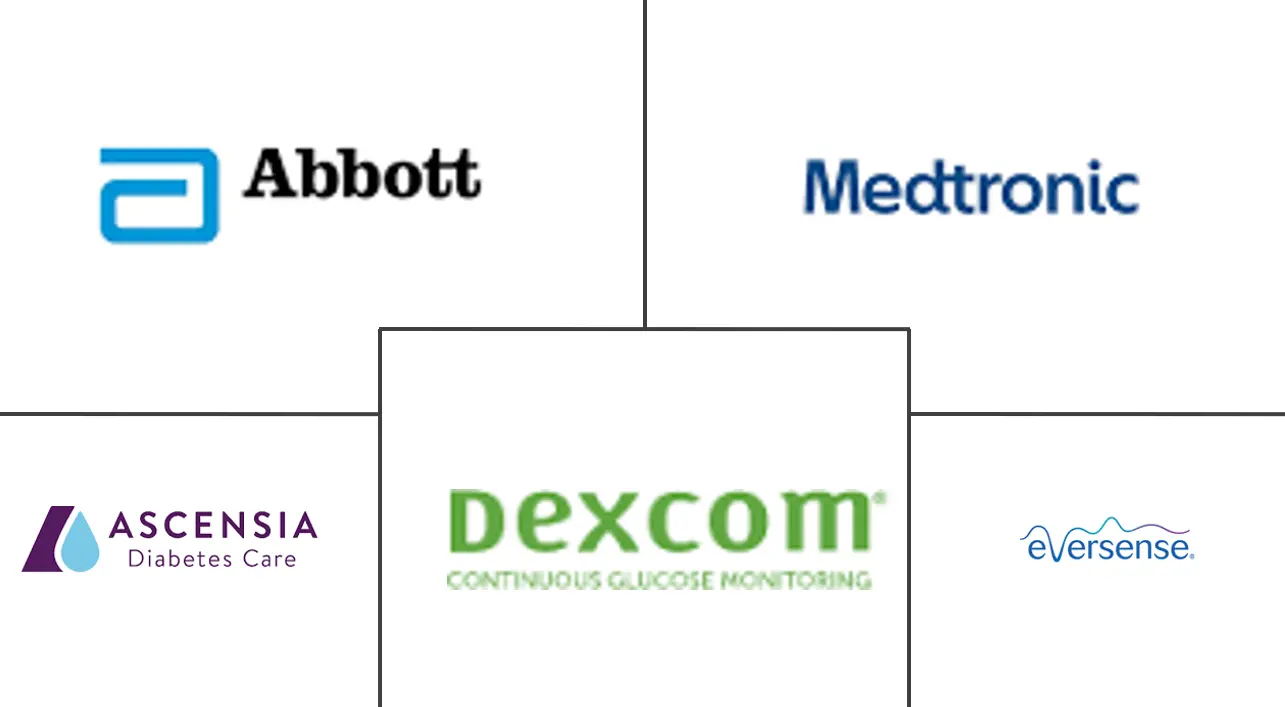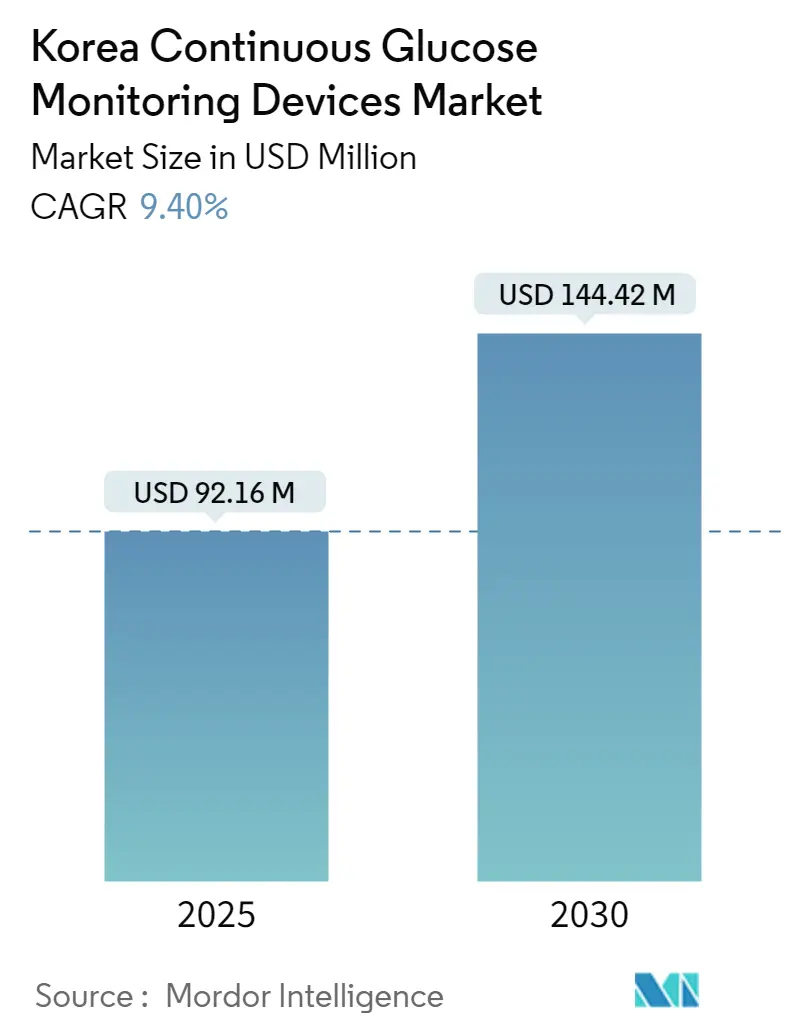
Korea Continuous Glucose Monitoring Devices Market Analysis by Mordor Intelligence
The Korea Continuous Glucose Monitoring Devices Market size is estimated at USD 92.16 million in 2025, and is expected to reach USD 144.42 million by 2030, at a CAGR of 9.4% during the forecast period (2025-2030).
Diabetes was one of the main comorbidities closely related to the risk of mortality and severe clinical outcomes in patients with COVID-19. Numerous epidemiological findings consistently suggested that the proportion of diabetes was higher in COVID-19 patients with a severe clinical course and that people with diabetes were also more vulnerable to COVID-19 infection than those without diabetes.
During the pandemic, health providers or diabetic patients were required to minimize contact and quarantine, and telehealth provided alternative support in preventing acute complications and controlling severe hyperglycemia. People with diabetes who were not infected with the SARS-CoV-2 were also recommended to maintain optimal glycemic control as part of the primary prevention of COVID-19.
The primary use of CGMS is for patients with type 1 or severe type 2 diabetes who are on insulin therapy. If insulin-dependent diabetics are dependent on SBGM, they should prick their fingers with needles up to 10 times a day to draw blood to measure blood glucose and, depending on the situation, inject insulin to avoid hyperglycemic or hypoglycemic shock. On the other hand, CGMS users can monitor their blood glucose changes for 1-7 days without any additional blood draw with a single sensor insertion.
The key factors propelling the market studied are increasing diabetes prevalence and the support initiatives taken by the Korean government.
Korea Continuous Glucose Monitoring Devices Market Trends and Insights
The Durables Segment is Expected to Witness the Highest Growth Rate Over the Forecast Period
A sensor's transmitter is what communicates blood glucose readings to a reader, receiver, or smartphone app. Devices known as receivers are those that collect data from transmitters and present the results on various user interfaces. According to the manufacturer, various CGM device components operate differently. These gadgets may need to be applied to the skin and are sometimes visible. Both disposable and rechargeable transmitter batteries are available. The market sector is anticipated to expand as a result of rising CGM device usage among diabetics, rising underlying causes of diabetes, market product availability, benefits of these durables, and increased awareness of CGM device use among Japanese consumers.
Korean NHIS is a single, compulsory health insurance system managed by the Korean government, providing healthcare coverage to almost the entire Korean population. The Korean NHIS database includes sociodemographic information, the use of medical services, medical claims, and health examinations. Koreans must register with NHIS as Type 1 Diabetics before requesting any insurance rebates, whether for consumables or CGMS. The patient can simply confirm this a day or two later by calling the NHI call center, but the patient's doctor will be able to do that for them. In order to apply for a refund for CGM Durables, Koreans needed an NHI refund form, prescription, cash receipt, and transaction statement.
Factors such as the increasing prevalence of diabetes, coupled with the increasing initiatives by public and private organizations, are expected to increase market growth in the country over the forecast period.
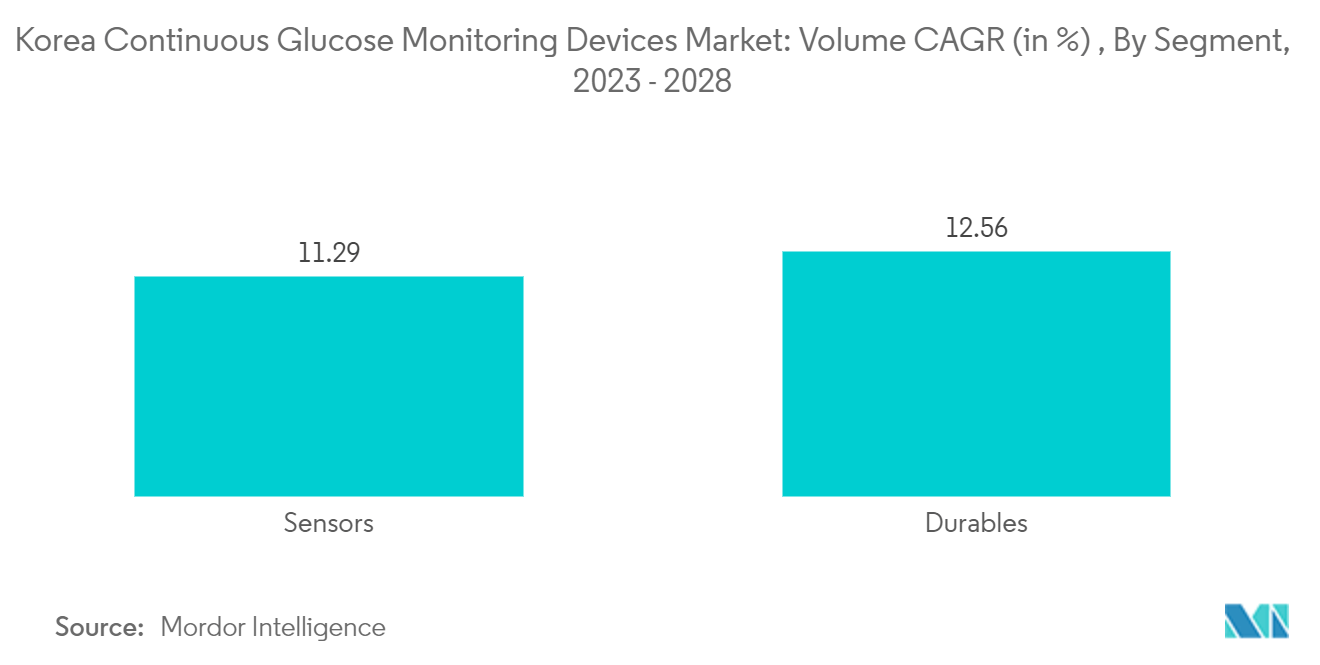
Rising Prevalence of Diabetes
The Type 1 diabetes population in Korea is expected to increase at a CAGR greater than 0.35% over the forecast period.
Type 1 diabetes and Type 2 diabetes are both chronic diseases characterized by high levels of glucose (sugar) in the blood. However, they differ in their causes, symptoms, and risk factors. Type 1 diabetes, also known as insulin-dependent diabetes, is caused by an autoimmune attack on the insulin-producing cells in the pancreas, leading to a complete lack of insulin production. It typically develops in childhood or early adulthood and requires daily injections of insulin to manage. Type 2 diabetes, on the other hand, is caused by insulin resistance (when the body can't effectively use insulin) combined with a decrease in insulin production. It is usually linked to lifestyle factors such as poor diet, lack of physical activity, and obesity and is more common in adults. It can often be managed through lifestyle changes such as diet and exercise, although some people with type 2 diabetes may also need medication or insulin therapy. Both types of diabetes can lead to serious health complications if not properly managed.
In January 2022, the Ministry of Food and Drug Safety (MFDS), South Korea’s medical device market regulator, planned to roll out several amendments to the country’s Medical Devices Act and has also expanded its list of devices eligible for electronic indications for use. Penetration of remote patient monitoring devices in the South Korean market supports local clinical research organizations (CROs) in their clinical research trials and ensures ease of monitoring, which facilitates the discovery process.
Diabetes is one of the country's most prevalent chronic diseases. Thus, the increasing prevalence of diabetes is expected to increase the adoption of continuous glucose monitoring in the country, which is expected to increase market growth over the forecast period.
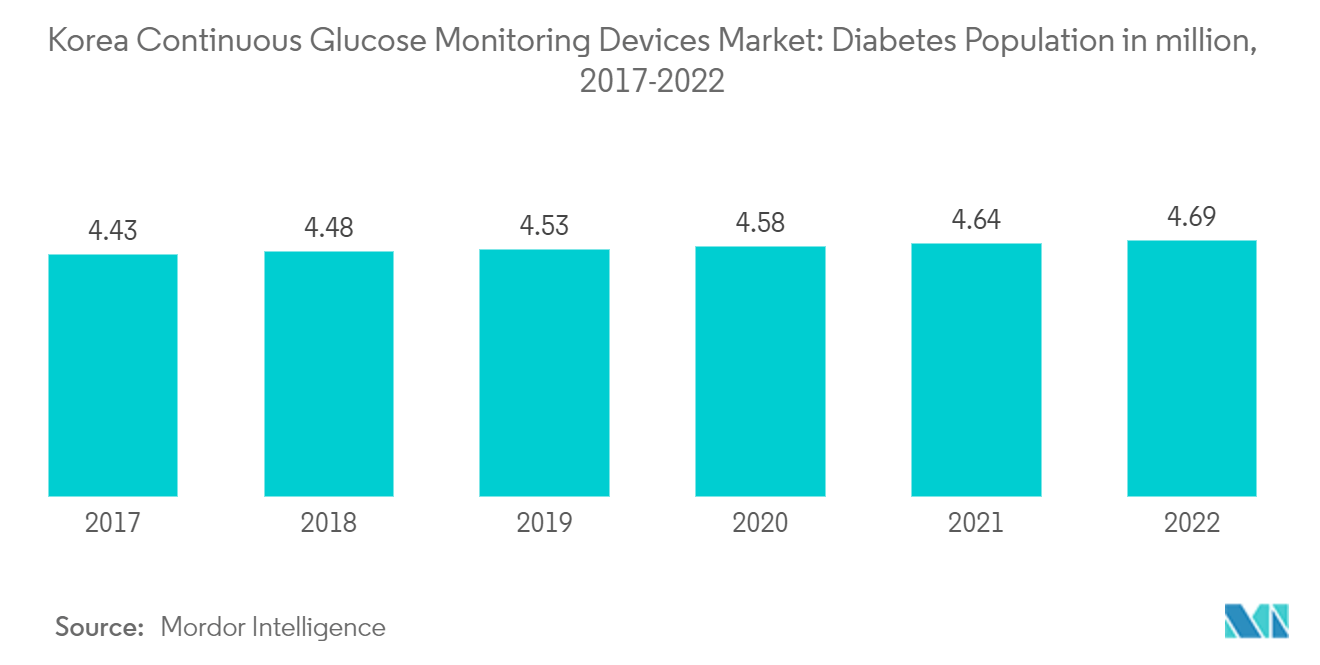
Competitive Landscape
The Korean continuous glucose monitoring devices market is highly consolidated. Market leaders such as Dexcom, Abbott, and Medtronic are focusing on product launches and technological collaborations to increase their foothold in the market.
Korea Continuous Glucose Monitoring Devices Industry Leaders
-
Dexcom
-
Abbott
-
Medtronic
-
Everesense
-
Ascenscia
- *Disclaimer: Major Players sorted in no particular order
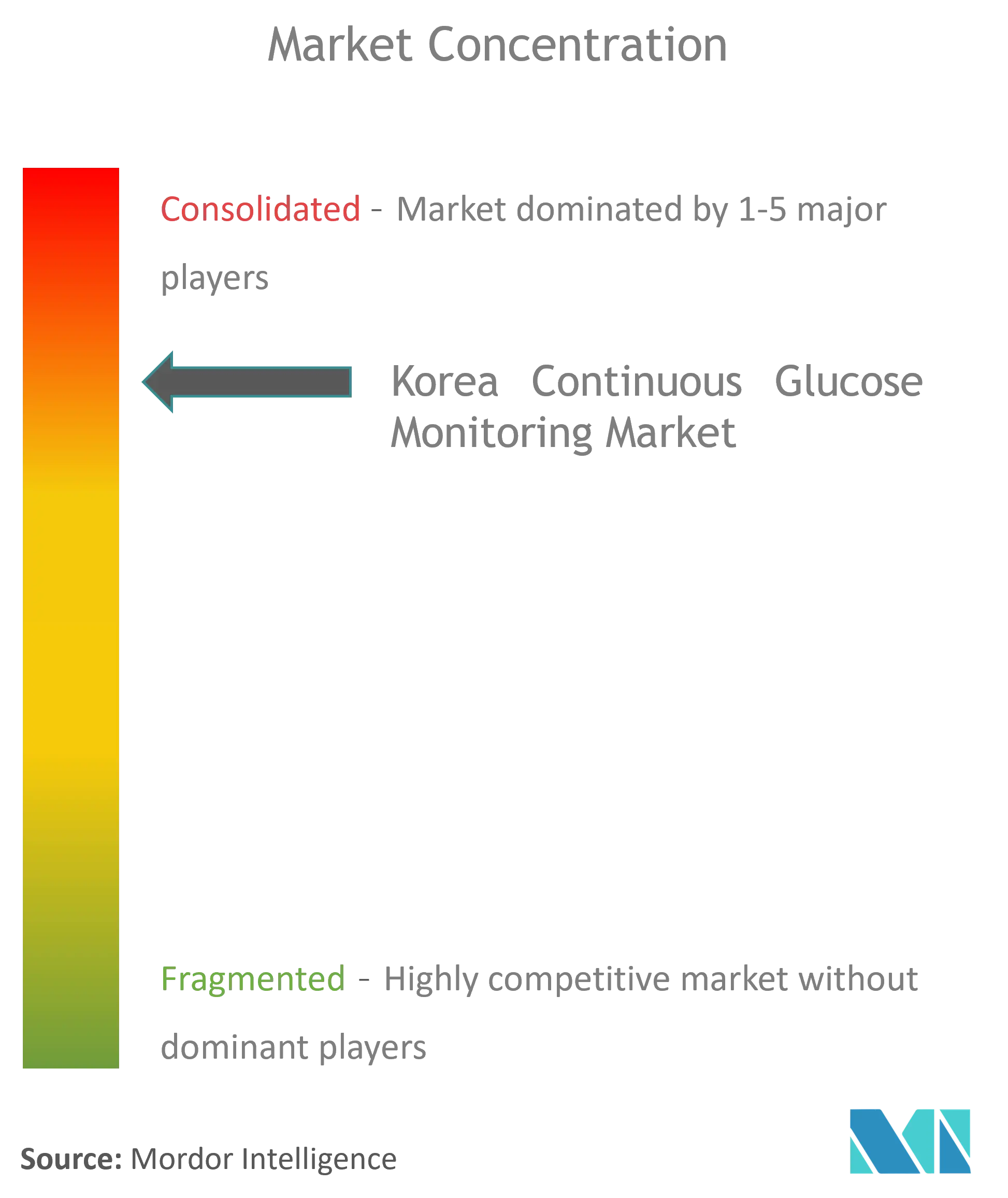
Recent Industry Developments
- May 2023: Medtronic PLC announced that it entered into a set of definitive agreements to acquire EOFlow Co. Ltd, manufacturer of the EOPatch device, a tubeless, wearable, and fully disposable insulin delivery device. The addition of EOFlow, Medtronic's Meal Detection Technology algorithm, and next-generation continuous glucose monitor are expected to expand the company's ability to address the needs of more individuals with diabetes.
- Jan 2023: Adela (Online Selling website for Abbott FreeStyle Libre in Korea) announced that the freestyle libre selling price would inevitably rise by 10% in Korea due to a continuous rise in raw materials and inflation.
Korea Continuous Glucose Monitoring Devices Market Report Scope
A tiny sensor that is commonly implanted under the skin on the abdomen or arm is how a CGM functions. Diabetes patients' interstitial glucose level, or the glucose present in the fluid between their cells, is measured by the sensor. Every few minutes, the sensor measures the glucose. The data is wirelessly transmitted from a transmitter to a monitor. The Korean continuous glucose monitoring devices market is segmented by individual components such as sensors and durables (receivers and transmitters) and By Provinces. The report offers the value (in USD) and volume (in units) for the above segments.
| Sensors |
| Durables (Receivers and Transmitters) |
| Seoul |
| Busan |
| Daegu Metropolitan City |
| Incheon Metropolitan City |
| Gwangju |
| Other Provinces |
| By Component | Sensors |
| Durables (Receivers and Transmitters) | |
| By Provinces (Quantitative Analysis) | Seoul |
| Busan | |
| Daegu Metropolitan City | |
| Incheon Metropolitan City | |
| Gwangju | |
| Other Provinces |
Key Questions Answered in the Report
How big is the Korea Continuous Glucose Monitoring Devices Market?
The Korea Continuous Glucose Monitoring Devices Market size is expected to reach USD 92.16 million in 2025 and grow at a CAGR of 9.40% to reach USD 144.42 million by 2030.
What is the current Korea Continuous Glucose Monitoring Devices Market size?
In 2025, the Korea Continuous Glucose Monitoring Devices Market size is expected to reach USD 92.16 million.
Who are the key players in Korea Continuous Glucose Monitoring Devices Market?
Dexcom, Abbott, Medtronic, Everesense and Ascenscia are the major companies operating in the Korea Continuous Glucose Monitoring Devices Market.
What years does this Korea Continuous Glucose Monitoring Devices Market cover, and what was the market size in 2024?
In 2024, the Korea Continuous Glucose Monitoring Devices Market size was estimated at USD 83.50 million. The report covers the Korea Continuous Glucose Monitoring Devices Market historical market size for years: 2019, 2020, 2021, 2022, 2023 and 2024. The report also forecasts the Korea Continuous Glucose Monitoring Devices Market size for years: 2025, 2026, 2027, 2028, 2029 and 2030.
Page last updated on:
Korea Continuous Glucose Monitoring Devices Market Report
Statistics for the 2025 Korea Continuous Glucose Monitoring Devices market share, size and revenue growth rate, created by Mordor Intelligence™ Industry Reports. Korea Continuous Glucose Monitoring Devices analysis includes a market forecast outlook for 2025 to 2030 and historical overview. Get a sample of this industry analysis as a free report PDF download.
